[English] 日本語
 Yorodumi
Yorodumi- PDB-1o5d: Dissecting and Designing Inhibitor Selectivity Determinants at th... -
+ Open data
Open data
- Basic information
Basic information
| Entry | Database: PDB / ID: 1o5d | ||||||
|---|---|---|---|---|---|---|---|
| Title | Dissecting and Designing Inhibitor Selectivity Determinants at the S1 site Using an Artificial Ala190 Protease (Ala190 uPA) | ||||||
 Components Components |
| ||||||
 Keywords Keywords | BLOOD CLOTTING / hydrolase / Ala190 uPA / S1 site / selectivity / conserved water displacement hydrogen bond deficit / trypsin / thrombin / hepsin / factor VIIa | ||||||
| Function / homology |  Function and homology information Function and homology informationactivation of plasma proteins involved in acute inflammatory response / activation of blood coagulation via clotting cascade / coagulation factor VIIa / response to Thyroid stimulating hormone / response to astaxanthin / response to thyrotropin-releasing hormone / response to 2,3,7,8-tetrachlorodibenzodioxine / response to carbon dioxide / response to genistein / serine-type peptidase complex ...activation of plasma proteins involved in acute inflammatory response / activation of blood coagulation via clotting cascade / coagulation factor VIIa / response to Thyroid stimulating hormone / response to astaxanthin / response to thyrotropin-releasing hormone / response to 2,3,7,8-tetrachlorodibenzodioxine / response to carbon dioxide / response to genistein / serine-type peptidase complex / response to vitamin K / positive regulation of platelet-derived growth factor receptor signaling pathway / positive regulation of leukocyte chemotaxis / response to thyroxine / NGF-stimulated transcription / response to cholesterol / cytokine receptor activity / response to growth hormone / positive regulation of positive chemotaxis / Extrinsic Pathway of Fibrin Clot Formation / positive regulation of endothelial cell apoptotic process / positive regulation of blood coagulation / animal organ regeneration / positive regulation of TOR signaling / Transport of gamma-carboxylated protein precursors from the endoplasmic reticulum to the Golgi apparatus / Gamma-carboxylation of protein precursors / Removal of aminoterminal propeptides from gamma-carboxylated proteins / positive regulation of endothelial cell proliferation / serine-type peptidase activity / BMAL1:CLOCK,NPAS2 activates circadian expression / positive regulation of interleukin-8 production / circadian rhythm / phospholipid binding / protein processing / Golgi lumen / response to estrogen / cytokine-mediated signaling pathway / positive regulation of angiogenesis / blood coagulation / response to estradiol / : / protease binding / vesicle / response to hypoxia / positive regulation of cell migration / endoplasmic reticulum lumen / signaling receptor binding / external side of plasma membrane / serine-type endopeptidase activity / calcium ion binding / positive regulation of gene expression / cell surface / extracellular space / extracellular region / membrane / plasma membrane Similarity search - Function | ||||||
| Biological species |  Homo sapiens (human) Homo sapiens (human) | ||||||
| Method |  X-RAY DIFFRACTION / X-RAY DIFFRACTION /  SYNCHROTRON / SYNCHROTRON /  FOURIER SYNTHESIS / Resolution: 2.05 Å FOURIER SYNTHESIS / Resolution: 2.05 Å | ||||||
 Authors Authors | Katz, B.A. / Luong, C. / Ho, J.D. / Somoza, J.R. / Gjerstad, E. / Tang, J. / Williams, S.R. / Verner, E. / Mackman, R.L. / Young, W.B. ...Katz, B.A. / Luong, C. / Ho, J.D. / Somoza, J.R. / Gjerstad, E. / Tang, J. / Williams, S.R. / Verner, E. / Mackman, R.L. / Young, W.B. / Sprengeler, P.A. / Chan, H. / Mortara, K. / Janc, J.W. / McGrath, M.E. | ||||||
 Citation Citation |  Journal: J.Mol.Biol. / Year: 2004 Journal: J.Mol.Biol. / Year: 2004Title: Dissecting and designing inhibitor selectivity determinants at the S1 site using an artificial Ala190 protease (Ala190 uPA). Authors: Katz, B.A. / Luong, C. / Ho, J.D. / Somoza, J.R. / Gjerstad, E. / Tang, J. / Williams, S.R. / Verner, E. / Mackman, R.L. / Young, W.B. / Sprengeler, P.A. / Chan, H. / Mortara, K. / Janc, J.W. / McGrath, M.E. | ||||||
| History |
|
- Structure visualization
Structure visualization
| Structure viewer | Molecule:  Molmil Molmil Jmol/JSmol Jmol/JSmol |
|---|
- Downloads & links
Downloads & links
- Download
Download
| PDBx/mmCIF format |  1o5d.cif.gz 1o5d.cif.gz | 244.6 KB | Display |  PDBx/mmCIF format PDBx/mmCIF format |
|---|---|---|---|---|
| PDB format |  pdb1o5d.ent.gz pdb1o5d.ent.gz | 197.6 KB | Display |  PDB format PDB format |
| PDBx/mmJSON format |  1o5d.json.gz 1o5d.json.gz | Tree view |  PDBx/mmJSON format PDBx/mmJSON format | |
| Others |  Other downloads Other downloads |
-Validation report
| Summary document |  1o5d_validation.pdf.gz 1o5d_validation.pdf.gz | 710 KB | Display |  wwPDB validaton report wwPDB validaton report |
|---|---|---|---|---|
| Full document |  1o5d_full_validation.pdf.gz 1o5d_full_validation.pdf.gz | 726.8 KB | Display | |
| Data in XML |  1o5d_validation.xml.gz 1o5d_validation.xml.gz | 29.4 KB | Display | |
| Data in CIF |  1o5d_validation.cif.gz 1o5d_validation.cif.gz | 44 KB | Display | |
| Arichive directory |  https://data.pdbj.org/pub/pdb/validation_reports/o5/1o5d https://data.pdbj.org/pub/pdb/validation_reports/o5/1o5d ftp://data.pdbj.org/pub/pdb/validation_reports/o5/1o5d ftp://data.pdbj.org/pub/pdb/validation_reports/o5/1o5d | HTTPS FTP |
-Related structure data
| Related structure data |  1o5aC  1o5bC  1o5cC 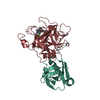 1o5eC 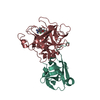 1o5fC  1o5gC C: citing same article ( |
|---|---|
| Similar structure data |
- Links
Links
- Assembly
Assembly
| Deposited unit | 
| ||||||||||
|---|---|---|---|---|---|---|---|---|---|---|---|
| 1 |
| ||||||||||
| Unit cell |
|
- Components
Components
| #1: Protein | Mass: 17046.975 Da / Num. of mol.: 1 / Fragment: light chain Source method: isolated from a genetically manipulated source Source: (gene. exp.)  Homo sapiens (human) / Gene: F7 / Plasmid: pCI-neo(Promega) / Cell line (production host): 293 / Organ (production host): embryonic kidney / Production host: Homo sapiens (human) / Gene: F7 / Plasmid: pCI-neo(Promega) / Cell line (production host): 293 / Organ (production host): embryonic kidney / Production host:  Homo sapiens (human) / References: UniProt: P08709, coagulation factor VIIa Homo sapiens (human) / References: UniProt: P08709, coagulation factor VIIa |
|---|---|
| #2: Protein | Mass: 28103.256 Da / Num. of mol.: 1 / Fragment: heavy chain (catalytic domain) Source method: isolated from a genetically manipulated source Source: (gene. exp.)  Homo sapiens (human) / Gene: F7 / Plasmid: pCI-neo(Promega) / Cell line (production host): 293 / Organ (production host): embryonic kidney / Production host: Homo sapiens (human) / Gene: F7 / Plasmid: pCI-neo(Promega) / Cell line (production host): 293 / Organ (production host): embryonic kidney / Production host:  Homo sapiens (human) / References: UniProt: P08709, coagulation factor VIIa Homo sapiens (human) / References: UniProt: P08709, coagulation factor VIIa |
| #3: Protein | Mass: 24739.434 Da / Num. of mol.: 1 / Mutation: residues 2-219 Source method: isolated from a genetically manipulated source Source: (gene. exp.)  Homo sapiens (human) / Description: ESCHERICHIA COLI / Gene: F3 / Plasmid: pET-21a(+) / Production host: Homo sapiens (human) / Description: ESCHERICHIA COLI / Gene: F3 / Plasmid: pET-21a(+) / Production host:  |
| #4: Chemical | ChemComp-CR9 / |
| #5: Water | ChemComp-HOH / |
| Has protein modification | Y |
-Experimental details
-Experiment
| Experiment | Method:  X-RAY DIFFRACTION / Number of used crystals: 1 X-RAY DIFFRACTION / Number of used crystals: 1 |
|---|
- Sample preparation
Sample preparation
| Crystal | Density Matthews: 3.07 Å3/Da / Density % sol: 59.92 % |
|---|---|
| Crystal grow | Temperature: 290 K / Method: vapor diffusion / pH: 7.2 Details: 0.1 M citrate, 16-18% PEG 5K MME, pH 7.2, vapor diffusion at 290 K |
-Data collection
| Diffraction | Mean temperature: 113 K |
|---|---|
| Diffraction source | Source:  SYNCHROTRON / Site: SYNCHROTRON / Site:  ALS ALS  / Beamline: 5.0.2 / Wavelength: 1 / Beamline: 5.0.2 / Wavelength: 1 |
| Detector | Type: ADSC QUANTUM 210 / Detector: CCD / Date: Mar 7, 2003 |
| Radiation | Protocol: SINGLE WAVELENGTH / Monochromatic (M) / Laue (L): M / Scattering type: x-ray |
| Radiation wavelength | Wavelength: 1 Å / Relative weight: 1 |
| Reflection | Resolution: 2.05→20 Å / Num. all: 52825 / Num. obs: 50184 / % possible obs: 95 % / Observed criterion σ(I): 0 / Redundancy: 2.8 % / Rmerge(I) obs: 0.051 / Net I/σ(I): 7.7 |
| Reflection shell | Resolution: 2.05→2.14 Å / % possible obs: 49.5 % / Rmerge(I) obs: 0.288 / Num. unique all: 6460 |
- Processing
Processing
| Software |
| ||||||||||||||||||||
|---|---|---|---|---|---|---|---|---|---|---|---|---|---|---|---|---|---|---|---|---|---|
| Refinement | Method to determine structure:  FOURIER SYNTHESIS / Resolution: 2.05→7 Å / Cross valid method: THROUGHOUT / σ(F): 2.4 / Stereochemistry target values: X-PLOR force field FOURIER SYNTHESIS / Resolution: 2.05→7 Å / Cross valid method: THROUGHOUT / σ(F): 2.4 / Stereochemistry target values: X-PLOR force fieldDetails: The Gla domain of the light chain (residue Ala L1 through Asp L46) is not visible (disordered). Some of the soluble tissue factor is not visible (disordered): Gly_T2 through Asn_T5;Gln T110 ...Details: The Gla domain of the light chain (residue Ala L1 through Asp L46) is not visible (disordered). Some of the soluble tissue factor is not visible (disordered): Gly_T2 through Asn_T5;Gln T110 through Glu T128; Trp T158 through Phe T187; Pro T206 through Met T210. Many of the waters may correspond to sporadic density in the regions of diordered protein. Residues simultaneously refined in two or more conformations are: Leu_L121, Lys_L137, Val_H138, Lys_H188, Ser_H190, Ser_T42 Discretely disordered waters are: HOH_94; A_HOH_578 is close to B_HOH578 which is close to A_HOH_581 which is close to B_HOH_581. HOH_858; HIS_H57 is doubly protonated. HIS_H91 is monoprotonated on the epsilon nitrogen No energy terms are included Og_Ser_H195, and O6' and HN3 of the inhibitor. These atoms form a short hydrogen-bonding network.
| ||||||||||||||||||||
| Refinement step | Cycle: LAST / Resolution: 2.05→7 Å
| ||||||||||||||||||||
| Refine LS restraints |
|
 Movie
Movie Controller
Controller


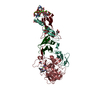
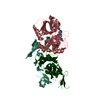
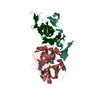
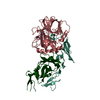


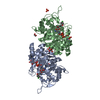
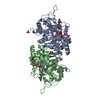
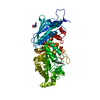
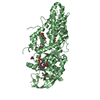
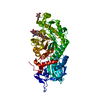
 PDBj
PDBj












